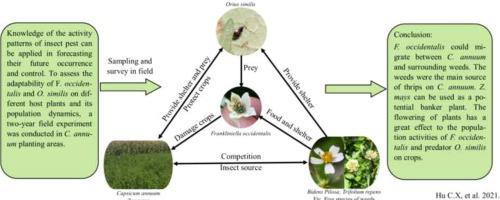Journal of Asia-Pacific Entomology ( IF 1.5 ) Pub Date : 2021-04-24 , DOI: 10.1016/j.aspen.2021.04.014 Changxiong Hu , Yiru Li , Guohua Chen , Pan Duan , Daohui Wu , Qing Liu , Honghui Yin , Tianyang Xu , Xiaoming Zhang

|
Frankliniella occidentalis Pergrande is important invasive pests in China, causing damage to agricultural production, and Orius similis Zheng is the dominant predator species of F. occidentalis. A two-year survey was conducted to determine the population density of F. occidentalis and O. similis, on chili (Capsicum annuum L.) and maize (Zea mays L.) crops and surrounding weed species, which included white clover (Trifolium repens L.), St. John's wort (Hypericum beanii N. Robson), alfalfa (Medicago sativa L.) and beggarticks (Bidens pilosa L.) in Kunming, southern China. The activity of F. occidentalis on these 6 host plant species was determined using the quartile method. F. occidentalis mainly damaged plants during their flowering stage. The main activity period of F. occidentalis occurred earlier on H. beanii and T. repens than on C. annuum. The peak activity of F. occidentalis occurred in the middle of May (on T. repens). During the whole activity period, the highest thrips densities were recorded on H. beanii among all of the sampled host plant species, followed by C. annuum. The lowest density was recorded on B. pilosa. Dynamics of immature F. occidentalis were more irregular than that of adults. The highest density of O. similis was recorded on Z. mays. It was 2.27–26.43-fold (2017) and 2.01–19.09-fold (2018) higher than that on other host plant species. This study showed that F. occidentalis could migrate between C. annuum and surrounding weeds. The weeds were the main source of thrips on C. annuum. The results indicated that Z. mays can be planted around C. annuum fields as a potential banker plant, to attract O. similis to control F. occidentalis on C. annuum, T. repens and B. pilosa. The flowering period of plants and surrounding plant species has a great effect to the population activities of F. occidentalis and predator O. similis on crops.



























 京公网安备 11010802027423号
京公网安备 11010802027423号